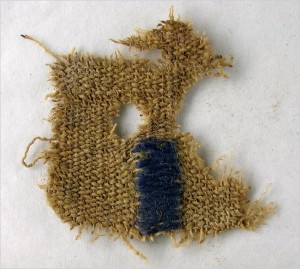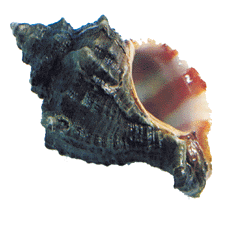
According to new research based on a discovery of an existing fragment of a Jewish garment from Masada, scientists have resolved the debate that the biblical blue (tekhelet) of the priestly garments and the ritual fringes (tzitzit) worn by every Israelite was made from the Murex trunculus, a sea snail living off the coast of Israel. The Talmud states:
“The hillazon is this: its body is like the sea, it’s creation is like a fish, it comes up once in 70 years and with its blood one dyes tekhelet – due to this it is expensive” (Men. 44a).

It is known from the Talmud as “hillazon,” and is not only responsible for creating the blue of the tekhelet, but also the expensive purple used for royalty.
The dye was also prohibitively expensive to make: hundreds of snails were used to make even a small batch, and some in ancient times claimed it was worth 20 times its weight in gold.
This explains the costliness of this dye in ancient times. It also sheds light on the occupation of Lydia from the New Testament:
And on the Sabbath day we went outside the gate to the riverside, where we supposed there was a place of prayer, and we sat down and spoke to the women who had come together. One who heard us was a woman named Lydia, from the city of Thyatira, a seller of purple goods, who was a worshiper of God. The Lord opened her heart to pay attention to what was said by Paul. And after she was baptized, and her household as well, she urged us, saying, “If you have judged me to be faithful to the Lord, come to my house and stay.” And she prevailed upon us. (Acts 16:13-15 ESV)
From Purple to Blue
Several years ago I remember reading an article somewhere about the discovery of this mollusk as the source of this dye. Those working with the mollusk attempting to reproduce the dye at first were not able to create the “sky blue” which we have today. The color they were able to produce was only purple. By “accident” (Divine providence?) they left a container of the mixture sitting in the sun a little longer than they intended, and when they applied it to the wool, the color was drastically different. Here is an account of this:
But if the snail we collected was identical to the one described by the rabbis over two millennia ago, why did it not produce the proscribed blue for our fringes? Why were we seeing only purple? The amazing answer to this conundrum, which baffled 20th-century scientists for decades, was discovered in the chemistry lab. In order to use this odoriferous dye, the snail extract must be reduced to achieve a solution. When this process is performed indoors, the result is a purple dye. But if, while in its reduced state, the dibromoindigo is exposed to the sun for a few minutes, the bromine invisibly breaks away from the molecule, leaving behind only indigo, the brilliant biblical blue.
According to Ptil Tekhelet, probably the authority on producing this dye, the resulting color of the dye is determined by the amount of ultraviolet exposure it receives.
Jesus/Yeshua
This blueish dye would have been the same dye Jesus would have worn on the corners of his garments according to the commandment in the book of Numbers:
The LORD said to Moses, “Speak to the people of Israel, and tell them to make tassels on the corners of their garments throughout their generations, and to put a cord of blue on the tassel of each corner. And it shall be a tassel for you to look at and remember all the commandments of the LORD, to do them, not to follow after your own heart and your own eyes, which you are inclined to whore after. So you shall remember and do all my commandments, and be holy to your God. I am the LORD your God, who brought you out of the land of Egypt to be your God: I am the LORD your God.” (Numbers 15:37-41 ESV)
This would have also been what the woman “with the issue of blood” would have reached out and touched on the “hem” of Jesus’ garment in Luke 8:43-48, which resulted in her healing.
- Read the NY Times article here
- Read up on tekhelet from Ptil Tekhelet
- Read more about the chemistry and discovery of tehkelet here
Similar Posts:
- Identity Theft Arrest Related to Dead Sea Scrolls Dispute
- New Text of Ben Sira Found Among Cairo Geniza Fragments
- Abraham the Disciple-Maker
- Historical House of Jesus Found?
- Eating the Messiah
Very cool!
I’m diggin'(no pun intended)the recent posts about the Temple blueprints and blue dye. Interesting!
Thanks, Justin. Great to hear from you!